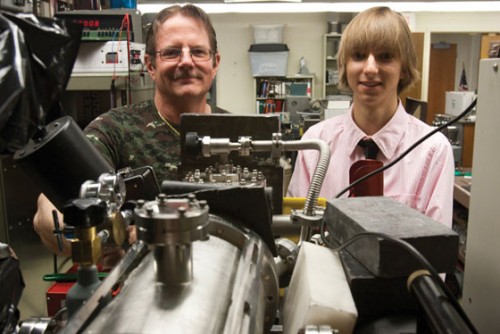Taylor Wilson makes people nervous. While his beanpole frame and Justin Bieber–esque haircut suggest he’s just a harmless kid, his after-school activities paint a far more ominous picture. At age 10, he built his first bomb out of a pill bottle and household chemicals. At 11, he started mining for uranium and buying vials of plutonium on the Internet. At 14, he became the youngest person in the world to build a nuclear fusion reactor. "I’m obsessed with radioactivity. I don’t know why," says Wilson in his laid-back drawl. "Possibly because there’s power in atoms that you can’t see, an unlocked power."
Shouldn’t teams in hazmat suits descend on Wilson and shut down his operations before someone gets hurt? On the contrary, there are people in the government who think that Wilson is key to keeping this country safe.
"The Cold War is really when nuclear physicists got their shot, and those people are all retiring," points out one of Wilson’s mentors, Ron Phaneuf, a professor of physics at the University of Nevada in Reno. "I think the U.S. Department of Energy is a little concerned that the motivation of young people to get interested in that kind of science has waned. I think that’s one of the reasons doors have been opened to Taylor. He’s a phenomenon, probably the most brilliant person I’ve met in my life, and I’ve met Nobel laureates."
When the U.S. Department of Homeland Security heard about Wilson two years ago, officials invited him to their offices to hear more about his research and determine whether or not it could be applied toward their counter-terrorism efforts. Because Wilson was only 15, they weren’t expecting much, but Wilson came prepared. After shaking everyone’s hands, he announced, "You know your building’s radio-active, right?" The pager-sized Geiger counter attached to Wilson’s belt was beeping, an indication that the granite surrounding them contained unusually high amounts of uranium—not enough to be harmful, but enough for Wilson to raise a few eyebrows.
"Their own building was radioactive and most didn’t know it," Wilson says. "That’s when they started to take me really seriously."
The Young Fusioneer
In the past year or so an unorthodox think-tank called Helena has been quietly bringing together an eclectic cross-section of brilliant individuals (mostly bright-eyed millennials) with ambitious goals. They're focusing on the world's biggest and most insurmountable problems: climate change and global security issues such as artificial intelligence, cryptocurrencies, and nuclear proliferation. The elite and edgy group includes Nobel laureates, Hollywood stars, technology entrepreneurs, human rights activists, Fortune-list executives, a North Korean refugee, and more, but one of Helena's most unique members is undoubtedly the 23-year old nuclear physicist Taylor Wilson, once known as "the boy who played with fusion".
Taylor Wilson garnered international attention from the science world in 2008 when he became the youngest person in history to produce nuclear fusion at just 14 years old, building a reactor capable of smashing atoms in a plasma core at over 500 million degrees Fahrenheit—40 times hotter than the core of the sun—in his parents' garage. And this all happened after he built a bomb at the age of 10. As a child in Texarkana, Arkansas, Taylor became infatuated with nuclear science after trysts with biology, genetics and chemistry. At age 11, while his classmates were playing with Easy-Bake Ovens, Wilson was taking his crack at building a particle accelerator in an effort to makes homemade radioisotopes.
Soon after he created a mini-sun in his garage, the wunderkind won $50,000 at a science fair for building a counterterrorism device that has the ability to detect nuclear materials in cargo containers, an invention which he later presented to Barack Obama in another science fair, this one sponsored by the White House.
In addition to counterterrorism and nuclear fusion, Wilson has also focused his optimistic virtuosity on solving some of the major shortcomings of our health industry. In his teenage years, Wilson also created a production system for medical isotopes that can be injected into patients and used to diagnose and treat cancer. His design costs less than $100,000 and can be wheeled directly into a hospital room, with the hope to replace multimillion-dollar, warehouse-size facilities that serve the same function.
Before he was even legally able to drink a beer, Wilson had already racked up 4 million views between his two (yes, two) TED Talks ( Yup, I Built A Nuclear Fusion Reactor and My Radical Plan For Small Nuclear Fission Reactors). He has a published biography written by author Tom Clynes as well as biopic in development to be directed by Jeff Nichols.
At 18, technically no longer a boy wonder but a legally-adult genius, Wilson skipped college and, armed with a $100,000 Thiel Fellowship, went straight to work trying to solve the same seemingly insurmountable problem that has had nuclear scientists scratching their heads for generation: how to translate the awesome power of nuclear fusion into harness able energy that would change the future of this planet.
Wilson has said that despite this —or perhaps because of this—assimilating into the science community was no cakewalk. In a profile for the Atlantic in 2012, Wilson said, "These days, the scientific community accepts me. But getting to that point was tremendously hard... when people have dedicated their lives to something—and spent eight years in college—they just expect that a kid wouldn't be up to doing it." However, Wilson thinks his greenness is exactly what makes him a forward-thinker and therefore a great scientist. "Kids have a certain predisposition to do things differently and see the world differently, and that's helpful... I think that we get a lot of scientists now who are bent into a system, and we lose some of their boldness."
It's exactly this young, optimistic, and daring energy that likely brought Wilson to the Helena think tank this year. In this meeting of the millennial minds, from backgrounds as diverse as Texarkana and Pyongyang, from disciplines as far-flung as nuclear fusion and human rights activism, and a whole lot of hopeful energy, it's hard to think that something incredible won't come out of it.
Among his peers, Wilson’s interest in science also has its perks. "At first when I was doing nuclear stuff I wondered, Is this going to make me a nerd? But I don’t think that was ever the case," he says. "I’ve even used it to pick up chicks. I take women to my lab sometimes." After all, what girl would be able to resist the line "Would you like to see my nuclear reactor?"

At 10, he built his first bomb. At 14, he made a nuclear reactor.




